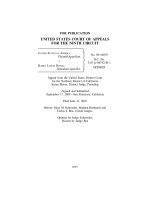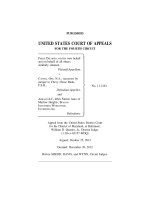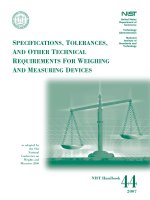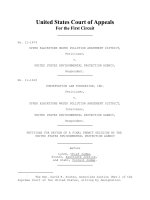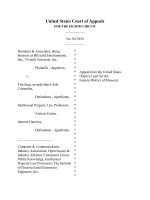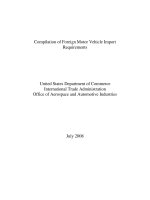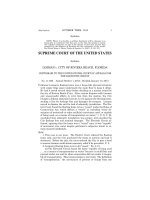United States Department of Agriculture Food Safety and Inspection Service, Office of Public Health Science
Bạn đang xem bản rút gọn của tài liệu. Xem và tải ngay bản đầy đủ của tài liệu tại đây (1.66 MB, 24 trang )
United States Department of Agriculture
Food Safety and Inspection Service, Office of Public Health Science
Page 1 of 24
CLG-MEL1.01
Title: Determination and Confirmation of Melamine by LC/MS/MS
Revision: 01
Replaces: CLG-MEL1.00
Effective: 12/02/2008
Contents
A.
INTRODUCTION ....................................................................................... 2
B.
EQUIPMENT ............................................................................................. 2
C.
REAGENTS AND SOLUTIONS ................................................................ 3
D.
STANDARDS ............................................................................................ 4
E.
SAMPLE PREPARATION ......................................................................... 5
F.
ANALYTICAL PROCEDURE..................................................................... 5
G.
DETERMINATION AND CONFIRMATION ............................................... 9
H.
SAFETY INFORMATION AND PRECAUTIONS..................................... 10
I.
QUALITY ASSURANCE PLAN ............................................................... 12
J.
WORKSHEET ......................................................................................... 14
K.
APPENDIX .............................................................................................. 16
L.
APPROVALS AND AUTHORITIES ......................................................... 24
United States Department of Agriculture
Food Safety and Inspection Service, Office of Public Health Science
Page 2 of 24
CLG-MEL1.01
Title: Determination and Confirmation of Melamine by LC/MS/MS
Revision: 01
A.
Replaces: CLG-MEL1.00
Effective: 12/02/2008
INTRODUCTION
1.
Theory and Structure
Melamine is extracted from ground beef tissue with an acetonitrile/water (50:50, v/v)
solution followed by a methylene chloride defat washing. The extract is cleaned through
a Waters Oasis MCX column. Quantitative analysis of melamine is performed by LC/MSMS with hydrophilic interaction chromatography (HILIC) and electrospray ionization in
positive ion mode.
2.
Applicability
This method is applicable for the determination and confirmation of Melamine in ground
beef at ≥ 50 ppb using triple quad and linear ion trap (See section B.2.a and B.2.b), and
ready to eat (RTE) products at ≥1 ppm using linear ion trap (see section B.2.b).
B.
EQUIPMENT
Note: Equivalent equipment may be substituted.
1.
Apparatus
SPE vacuum manifold - Supelco.
SPE Columns - Oasis, MCX 150 mg / 6 mL, Waters.
Centrifuge - Eppendorf 5810.
Centrifuge - Galaxy 14D, VWR.
50 mL glass disposable centrifuge tubes - Kimble 73785-50.
15 mL glass disposable centrifuge tubes - Kimble 73785-15.
Glass disposable culture tubes 13 mm x 100 mm - VWR 47729-572.
Microfilterfuge tubes 0.2 µm Nylon-66 - Rainin 7016-021.
United States Department of Agriculture
Food Safety and Inspection Service, Office of Public Health Science
Page 3 of 24
CLG-MEL1.01
Title: Determination and Confirmation of Melamine by LC/MS/MS
Revision: 01
Replaces: CLG-MEL1.00
Effective: 12/02/2008
N-EVAP - Organomation 112t.
2.
Instrumentation
a. Triple Quad (TQD)
Liquid Chromatograph - Waters Acquity UPLC, Waters Co.
Analytical Column - Waters Acquity UPLC, BEH HILIC Silica 1.7 µm, 2.1 x
100 mm, Waters.
Mass Spectrometer - Waters TQD, Waters Co.
b. Linear Ion Trap (LTQ)
Liquid Chromatograph – Agilent 1200 HPLC, Agilent Technologies.
Analytical Column - Waters Acquity UPLC, BEH HILIC Silica 1.7 µm,
2.1x100 mm, Waters.
Mass Spectrometer – Thermo Finnigan LTQ, Thermo Finnigan.
C.
REAGENTS AND SOLUTIONS
Note: Equivalent reagents and solutions may be substituted.
1.
Reagents
a. Methanol – Optima HPLC Grade, CAT No A454-4, Fisher.
b. Acetonitrile – Optima, 0.2μm filtered, CAT No A996-4, Fisher.
c. Water – Optima, 0.5μm filtered, CAT No W7-4, Fisher.
d. Methylene Chloride – 99.8%, GC, CAT No 66741, Fluka.
e. Ammonium Formate – 96% min, CAT No JTM530-8, J T Baker.
f.
Ammonium Hydroxide – ACS, CAT No AX1303-6, EMD.
g. Hydrochloric Acid – 1.0 ± 0.002 N, CAT. No VW3202-1, VWR.
2.
Solutions
a. Extraction Solvent: Acetonitrile: water 1:1 (v/v):
Mix well 500 mL acetonitrile and 500 mL Optima water.
b. 20 mM ammonium formate in water:
Prepare 1 liter by diluting approximately 1.25 grams of Ammonium
Formate in 1 liter of Optima water.
c. 0.1N Hydrochloric Acid:
United States Department of Agriculture
Food Safety and Inspection Service, Office of Public Health Science
Page 4 of 24
CLG-MEL1.01
Title: Determination and Confirmation of Melamine by LC/MS/MS
Revision: 01
Replaces: CLG-MEL1.00
Effective: 12/02/2008
Dilute 100 mL 1N Hydrochloric Acid to 1 liter with Optima water.
d. 5% (v/v) ammonium hydroxide in acetonitrile:
Dilute 5 mL ammonium hydroxide into 95 mL Optima water. Mix well.
e. 50% (v/v) methanol in Optima water:
Dilute 50 mL methanol into 50 mL of Optima water. Mix well.
D.
STANDARDS
1.
Reference Standard
Common Name: Melamine.
Chemical Name: 2,4,6-Triamino-1,2,5-Triazine.
Chemical Formula: C3H6N6.
Molecular Weight: 126.12.
Source: TCI CAT No T0337.
Storage: Store in a closed container in a cool dry place.
2.
Preparation of Melamine Standard Solutions
a. Stock Standard (1 mg/mL):
Weigh 10 mg melamine in a 10 mL volumetric flask and bring to volume with
50% (v/v) methanol in Optima water.
b. Working standards
i.
10 µg/mL:
Pipet 100 μL stock standard into a 10 mL volumetric flask and bring to
volume with acetonitrile.
ii.
100 µg/mL:
Pipet 1000 μL stock standard into a 100 mL volumetric flask and bring
to volume with acetonitrile.
c. LC/MS-MS standard curve solutions:
Dilute 0, 10, 25, 50, and 75 μL of the 10 µg/mL working standard into 5 tubes
to 10 mL with acetonitrile, as shown in the following table:
United States Department of Agriculture
Food Safety and Inspection Service, Office of Public Health Science
Page 5 of 24
CLG-MEL1.01
Title: Determination and Confirmation of Melamine by LC/MS/MS
Revision: 01
Replaces: CLG-MEL1.00
Effective: 12/02/2008
Calibration
Level
Volume
working
standard
solution (μL)
Volume
acetonitrile (μL)
Calibration standard
concentration (ng/mL)
(ppb)
0
1
2
3
4
0
10
25
50
75
10000
9990
9975
9950
9925
0
10
25
50
75
Storage and Stability:
Store stock standard solution (1 mg/mL) tightly closed at room temperature. This
solution is stable for 1 year.
Store working standard solution (10 μL/mL) tightly closed at room temperature. This
solution is stable for 1 month.
Standard curve solutions are stable for 3 weeks.
E.
SAMPLE PREPARATION
Sample size: 25 grams.
Blend sample until homogeneous.
Sample type: ground beef.
RTE products : e.g. cheese dogs, sausage, chicken fingers, meatballs,
baby foods (meats), etc.
Store samples in glass containers at -20°C.
F.
ANALYTICAL PROCEDURE
1.
Extraction
a. Weigh 5 ± 0.05 g of thawed homogenized sample in duplicate into a 50 mL
centrifuge tube.
Ground beef :, weigh two 5.0 ± 05 g of blank tissue into 50 mL centrifuge
tubes. Use the first tube as a negative blank and fortify the second tube as a
recovery by adding 25 μL of working standard (10 µg/mL ) for a 50 ppb
recovery.
RTE products: weigh two 5.0 ± 05 g of blank tissue into 50 mL centrifuge
tubes. Use the first tube as a negative blank and fortify the second tube as a
recovery by adding 50 μL of working standard (100 µg/mL) for a 1 ppm
recovery.
United States Department of Agriculture
Food Safety and Inspection Service, Office of Public Health Science
Page 6 of 24
CLG-MEL1.01
Title: Determination and Confirmation of Melamine by LC/MS/MS
Revision: 01
Replaces: CLG-MEL1.00
Effective: 12/02/2008
b. Add 25 mL extraction solvent, acetonitrile/water 1:1 solution, into each tube
and vortex or shake vigorously for approximately 1 min or until sample is
thoroughly mixed.
c. Centrifuge at 2500 rpm for 10 min. Transfer 5 mL of the supernatant into a
15 mL centrifuge tube.
2.
Methylene Chloride Wash
a. Add 250 μL of 1N HCl to the tube and add enough methylene chloride to fill
the tube to 2 cm from the top. Cap and shake for approximately 1 min. Check
the pH of the solution with a pH strip, the pH should be below 6.0. Adjust pH
if necessary with 1N HCl.
b. Centrifuge at 2500 rpm for 10 min. Transfer the upper layer to a 15 mL glass
culture tube.
c. Extract the sample in the centrifuge tube a second time by adding
approximately 4 mL Optima water. Cap and shake for approximately 1 min.
d. Centrifuge at 2500 rpm for 10 min. Transfer the upper layer to the glass
culture tube containing the first transfer.
3.
SPE Cleanup
Note: For elutions in steps a, b, c, and e below use gravity flow, do not use
vacuum.
a. Condition the Oasis MCX with 5 mL methanol followed by 5 mL Optima
water.
b. Load sample onto the column. Discard the eluate.
c. Wash column with 5 mL 0.1 N HCl followed by 2 mL methanol. Discard
eluates.
d. Aspirate the column for approximately 30 sec using vacuum. Discard eluate.
e. Elute the sample by gravity with 5 mL 5% (v/v) ammonium hydroxide in
acetonitrile into a glass culture tube.
f.
Gently evaporate sample to about 1.5 mL on N-EVAP at approximately
60 °C.
Ground Beef: transfer quantitatively into 2 mL volumetric flask by washing
culture tube with acetonitrile and bring to volume. Mix well.
RTE Products: transfer quantitatively into 25 mL volumetric flask by washing
culture tube with acetonitrile and bring to volume. Mix well.
g. Transfer a portion of the sample to a microfilterfuge tube and centrifuge at
United States Department of Agriculture
Food Safety and Inspection Service, Office of Public Health Science
Page 7 of 24
CLG-MEL1.01
Title: Determination and Confirmation of Melamine by LC/MS/MS
Revision: 01
Replaces: CLG-MEL1.00
Effective: 12/02/2008
8000 rpm for 5 minutes. Transfer about 300 μL of the filtered solution to an
LC injection vial containing a glass insert.
4.
Instrumental Settings
Note: The following instrument parameters may be optimized.
a.
Triple Quad (TQD)
i.
LC Parameters:
Flow: 0. 4 mL/min.
Injection volume: 2 μL
Autosampler Temp: 20 °C
Run Time: 6 min.
Column Temp.: 45 °C
Solvent A: 20 mM ammonium formate
Solvent B: Acetonitrile
HPLC Mobile Phase Gradient Table:
Run time
(min)
0
2.0
2.1
3.1
3.2
8.0
ii.
Flow
rate
(mL/min)
0.4
0.4
0.4
0.4
0.4
0.4
Solvent A
%
Solvent B
(%)
10
10
50
50
10
10
90
90
50
50
90
90
MS Parameters:
The LC-MS-MS electrospray (ESI) conditions are optimized by
tuning with a 10 ng/µL solution of Melamine dissolved in 90:10
(v/v) acetonitrile:ammonium formate buffer (20 mM) at 0.4 mL/min.
Optimize for m/z 127 for parent and m/z 85 for product
Spray Voltage: 3.5 kV
Desolvation flow: 900 L/hr
United States Department of Agriculture
Food Safety and Inspection Service, Office of Public Health Science
Page 8 of 24
CLG-MEL1.01
Title: Determination and Confirmation of Melamine by LC/MS/MS
Revision: 01
Replaces: CLG-MEL1.00
Effective: 12/02/2008
Cone flow: 20 L/hr
Capillary Temperature: 350 °C
MRM: Parent 127; Daughters 85 and 68
ESI Positive ion mode
b. Linear Ion Trap (LTQ)
i.
LC Parameters:
Flow: 0. 350 mL/min
Injection volume: 1.0 μL
Autosampler Temp: off
Run Time: 10 min.
Column Temp.: 45 °C
Solvent A: 20 mM ammonium formate
Solvent B: Acetonitrile
HPLC Mobile Phase Gradient Table:
Run time
(min)
0
4.0
4.1
10.0
ii.
Flow
rate
(mL/min)
0.350
0.350
0.350
0.350
Solvent A
%
Solvent B
(%)
5
50
5
5
95
50
95
95
MS Parameters
The LC-MS-MS electrospray (ESI) conditions are optimized by
tuning with a 10 ng/µL solution of Melamine dissolved in 90:10
(v/v) acetonitrile:ammonium formate buffer (20 mM) at
0.350 mL/min.
Optimize for m/z 127 for parent and m/z 85 for product
Source Voltage: 4.5 kV
Capillary Voltage: 4.0 V
United States Department of Agriculture
Food Safety and Inspection Service, Office of Public Health Science
Page 9 of 24
CLG-MEL1.01
Title: Determination and Confirmation of Melamine by LC/MS/MS
Revision: 01
Replaces: CLG-MEL1.00
Effective: 12/02/2008
Sheath flow: 78
Aux flow: 30.0
Sweep flow: 19.0
Capillary Temperature: 300 °C
ESI Positive ion mode
G.
DETERMINATION AND CONFIRMATION
Note: Because final dilution of the sample equals to approximately 0.5 grams per mL,
each fortified sample is equivalent to half of its value in tissue. (Example; a found
50 ng/mL is equivalent to ~100 ng/g in tissue)
1.
Determination Triple Quad (TQD)
a.
Determine retention times and peak areas for all standards, controls, and
samples.
b.
The Chromatographic peak (127 → 85 transition) of the standard and
fortified sample should have a signal to noise ratio greater than 3.
c.
Using a linear regression analysis, construct a standard curve. Plot peak
area (area counts m/z 127 → 85) (y-coordinate) against standard
concentration (ng/mL) (x-coordinate). Calculate slope, intercept, and
correlation coefficient (r) of the regression line. Samples may be
quantified only if the correlation coefficient calculated equals or exceeds
0.995 and sample response is within the standard calibration curve.
d.
Identification of melamine in a sample requires that its chromatogram
shows a peak eluting with a retention time within ± 5% of that determined
for the melamine peak in the fortified sample.
e.
Calculate melamine concentration in samples using the equation:
Melamine (ppb) = ((Area for m/z 85 – Y intercept)/Slope) * (Dilution
Factor/Weight)
Note: Dilution factor ≈ 2
2.
Confirmation Triple Quad (TQD)
a.
Product ion abundance ratios must match that of the external standard
within 10% absolute difference. The following dissociated ions are
monitored;
United States Department of Agriculture
Food Safety and Inspection Service, Office of Public Health Science
Page 10 of 24
CLG-MEL1.01
Title: Determination and Confirmation of Melamine by LC/MS/MS
Revision: 01
Replaces: CLG-MEL1.00
Effective: 12/02/2008
m/z 127 → 85
m/z 127 → 68
3.
b.
The solvent blank analyzed after the recovery must be negative for
melamine.
c.
The tissue blank must be negative for melamine.
d.
The fortified tissue must be positive for melamine.
Determination Linear Ion Trap (LTQ)
a.
Determine retentions times and peak areas for the daughter ion at 85 m/z
for all standards, controls, and samples.
b.
The Chromatographic peak for daughter ion 85 m/z of the standard and
fortified sample should have a signal to noise ratio greater than 20.
c.
Using a linear regression analysis, construct a standard curve. Plot peak
area (area counts m/z 85) (y-coordinate) against standard concentration
(ng/mL) (x-coordinate). Calculate slope, intercept, and correlation
coefficient (r) of the regression line. Samples may be quantified only if the
correlation coefficient calculated equals or exceeds 0.995 and sample
response is within the standard calibration curve.
d.
Identification of melamine in a sample requires that its chromatogram
shows a peak eluting with a retention time within ± 5% of that determined
for the melamine peak in the fortified sample.
e.
Calculate melamine concentration in samples using the equation:
Melamine (ppb) = ((Area for m/z 85 – Y intercept)/Slope) * (Dilution
Factor/Weight)
Note: Dilution factor ≈ 2
4
H.
Confirmation Linear Ion Trap (LTQ)
a.
The full MS2 spectrum obtained from the molecular ion at m/z 127 in the
samples should visually match the spectrum obtained form the standards.
b.
At least three structurally-significant ions are present (m/z 68, 110, 85,
and 127).
c.
There should be general correspondence between the relative
abundances of the samples and those of the standards.
SAFETY INFORMATION AND PRECAUTIONS
1.
Required Protective Equipment: Protective clothing, eyewear, and gloves.
United States Department of Agriculture
Food Safety and Inspection Service, Office of Public Health Science
Page 11 of 24
CLG-MEL1.01
Title: Determination and Confirmation of Melamine by LC/MS/MS
Revision: 01
2.
Replaces: CLG-MEL1.00
Hazards
Reagent
Hazard
Methanol
Poison, flammable.
Acetonitrile
Flammable, Irritant, harmful
if swallowed, inhaled or
absorbed through the skin.
Methylene Chloride
Harmful if swallowed or
inhaled. Causes eye, skin,
and respiratory track
irritation. Potential cancer
hazard.
Ammonium Formate
Irritant. Hygroscopic.
Ammonium Hydroxide
Corrosive. Causes burns.
Harmful if swallowed
Hydrochloric Acid
Corrosive. Causes burns.
Fatal if inhaled or
swallowed.
3.
Effective: 12/02/2008
Recommended Safe Procedures
Wear eye protection, gloves,
and lab coat. Use only with
adequate ventilation. Keep away
from heat, sparks, and open
flames.
Wear eye protection, gloves,
and lab coat. Use only with
adequate ventilation. Keep away
from heat, sparks, and open
flames.
Wear eye protection, gloves,
and lab coat. Use only with
adequate ventilation. Keep away
from heat, sparks, and open
flames. Keep from contact with
oxidizers.
Wear eye protection, gloves,
and lab coat. Use only with
adequate ventilation.
Wear eye protection, gloves,
and lab coat. Use only with
adequate ventilation. Store in
caustic corrosives area. Keep
from contact with oxidizers.
Wear eye protection, gloves,
and lab coat. Use only with
adequate ventilation. Store in
acid corrosives area. Store
away from oxidizers and alkalis.
Disposal Procedures
Reagent
Hazard
Methanol
See section 2
above
Acetonitrile
See section 2
above
Recommended Safe Procedures
Collect waste in a sealed container and store in
a cool, well ventilated. Flammable liquid storage
area/cabinet for disposal in accordance with
local, state, and Federal regulations.
Collect waste in a ground tightly closed
container. Keep from contact with oxidizing
United States Department of Agriculture
Food Safety and Inspection Service, Office of Public Health Science
Page 12 of 24
CLG-MEL1.01
Title: Determination and Confirmation of Melamine by LC/MS/MS
Revision: 01
Replaces: CLG-MEL1.00
Hazard
Reagent
I.
Methylene Chloride
See Section 2
above
Hydrochloric Acid
See section 2
above
Ammonium Formate
See section 2
above
Ammonium
Hydroxide
See section 2
above
Effective: 12/02/2008
Recommended Safe Procedures
materials. Store in a cool, well ventilated
flammables area.
Collect waste in tightly closed container. Keep
from contact with oxidizing materials. Store in a
cool, dry, well ventilated area.
Collect waste in a sealed container and store in
a cool, well ventilated away from incompatibles.
Acid liquid storage area/cabinet for disposal in
accordance with local, state, and Federal
regulations.
Collect waste in a sealed container and store in
a cool, well ventilated, away from oxidizers.
Dispose in accordance with local, state, and
Federal regulations.
Collect waste in sealed container and store in a
cool, well ventilated room, away from oxidizing
agents, acids, halogen, silver nitrite, dimethyl
sulfate, silver oxide. Dispose in accordance
with local, state and Federal regulations.
QUALITY ASSURANCE PLAN
1.
Performance Standard
Analyte
Sample Analytical Range
25 - 100 ng/g (ground beef)
0.5 - 2 μg/g (RTE products)
Melamine
2.
a.
b.
c.
3.
Acceptable
Recovery
Acceptable
Repeatability
(CV)
70 -110%
20%
Critical Control Points and Specifications
Record
Acceptable Control
Sample weight
Evaporation
Sample pH (Section F.2.a)
5.0 ± 0.05 g
Avoid evaporation to dryness
pH < 6.0
Readiness To Perform
a.
Familiarization
i.
Phase I: Standards- Generate a standard curve in duplicate on
United States Department of Agriculture
Food Safety and Inspection Service, Office of Public Health Science
Page 13 of 24
CLG-MEL1.01
Title: Determination and Confirmation of Melamine by LC/MS/MS
Revision: 01
Replaces: CLG-MEL1.00
Effective: 12/02/2008
three working days at the following levels:
0 ng/mL
10 ng/mL
25 ng/mL
50 ng/mL
75 ng/mL
ii.
Phase II: Fortified samples. Analyze in duplicate on three
different days five samples fortified at the following levels:
(a) Ground beef:
0 ppb and 50 ppb
(b) RTE Products:
0 ppm and 1ppm
NOTE: Phase I and Phase II may be performed concurrently.
iii.
Phase III: Check samples for analyst accreditation.
(a) Six unknown samples fortified at levels from 0 to 100 ppb
(ground beef) and 0.5 to 2.0 ppm (RTE products), one of which
should at the zero level. Fortification scheme is provided and
dispensed by supervisor/designee or Quality Assurance Manager
(QAM).
(b) Report analytical findings to supervisor.
(c) A letter from QAM is required to commence official analysis.
b.
Acceptability criteria.
Refer to section I.1-3 above.
4.
Intralaboratory Check Samples
a.
System, minimum contents.
i.
Frequency: At least one blind check sample per analyst, per week,
when samples are analyzed.
ii.
Records to be maintained by analyst and reviewed by supervisor
United States Department of Agriculture
Food Safety and Inspection Service, Office of Public Health Science
Page 14 of 24
CLG-MEL1.01
Title: Determination and Confirmation of Melamine by LC/MS/MS
Revision: 01
Replaces: CLG-MEL1.00
b.
Effective: 12/02/2008
Acceptability criteria.
If unacceptable values are obtained,
5.
6.
i.
Stop all official analyses by that analyst.
ii.
Take corrective action.
Sample Acceptability and Stability
a.
Matrix: fresh ground beef and RTE products (e.g. cheese dogs, sausage,
chicken fingers, meatballs, baby food (meat)).
b.
Sample receipt size: minimum: 30 g.
c.
Condition upon receipt: Cold (< 10° C).
d.
Shelf life: 6 months.
e.
Storage Condition: Store samples in glass containers at -20° C.
Sample Set
All of the standards, samples, and quality control samples are to be analyzed in a
single automated run.
Each set must contain:
7.
a.
Solvent blank
b.
Standard solutions
c.
A negative blank tissue
d.
A fortified blank tissue at 50 ppb for ground beef, 1 ppm for RTE products
e.
Sample extracts
Sensitivity
Minimum proficiency level (MPL): 50 ppb (ground beef); 1 ppm (RTE products)
J.
WORKSHEET
Following is an example of a worksheet.
United States Department of Agriculture
Food Safety and Inspection Service, Office of Public Health Science
Page 15 of 24
CLG-MEL1.01
Title: Determination and Confirmation of Melamine by LC/MS/MS
Revision: 01
Replaces: CLG-MEL1.00
Effective: 12/02/2008
United States Department of Agriculture
Food Safety and Inspection Service, Office of Public Health Science
Page 16 of 24
CLG-MEL1.01
Title: Determination and Confirmation of Melamine by LC/MS/MS
Revision: 01
K.
Replaces: CLG-MEL1.00
Effective: 12/02/2008
APPENDIX
1.
Chromatograms
a.
Melamine External Standard at 50 ppb
Figure 1. TQD Spectra of 50 ppb Melamine External Standard
United States Department of Agriculture
Food Safety and Inspection Service, Office of Public Health Science
Page 17 of 24
CLG-MEL1.01
Title: Determination and Confirmation of Melamine by LC/MS/MS
Revision: 01
Replaces: CLG-MEL1.00
Effective: 12/02/2008
Figure 2. LTQ Spectra of 50 ppb Melamine External Standard
United States Department of Agriculture
Food Safety and Inspection Service, Office of Public Health Science
Page 18 of 24
CLG-MEL1.01
Title: Determination and Confirmation of Melamine by LC/MS/MS
Revision: 01
b.
Replaces: CLG-MEL1.00
Effective: 12/02/2008
Negative Control (Blank) and Recovery Samples (Melamine 50 ppb), Ground
Beef
Figure 3. LTQ Spectra of Negative Control (Blank), Ground Beef
United States Department of Agriculture
Food Safety and Inspection Service, Office of Public Health Science
Page 19 of 24
CLG-MEL1.01
Title: Determination and Confirmation of Melamine by LC/MS/MS
Revision: 01
Replaces: CLG-MEL1.00
Effective: 12/02/2008
Figure 4. TQD Spectra of 50 ppb Melamine Recovery, Ground Beef
United States Department of Agriculture
Food Safety and Inspection Service, Office of Public Health Science
Page 20 of 24
CLG-MEL1.01
Title: Determination and Confirmation of Melamine by LC/MS/MS
Revision: 01
Replaces: CLG-MEL1.00
Effective: 12/02/2008
Figure 5. LTQ Spectra of 50 ppb Melamine Recovery, Ground Beef
United States Department of Agriculture
Food Safety and Inspection Service, Office of Public Health Science
Page 21 of 24
CLG-MEL1.01
Title: Determination and Confirmation of Melamine by LC/MS/MS
Revision: 01
c.
Replaces: CLG-MEL1.00
Effective: 12/02/2008
Negative Control (Blank) and Recovery Samples (Melamine 1 ppm), in Veal
Baby Food
Figure 6. LTQ Spectra of Negative Control (Blank), Veal Baby Food
United States Department of Agriculture
Food Safety and Inspection Service, Office of Public Health Science
Page 22 of 24
CLG-MEL1.01
Title: Determination and Confirmation of Melamine by LC/MS/MS
Revision: 01
Replaces: CLG-MEL1.00
Effective: 12/02/2008
Figure 7. LTQ Spectra of 1 ppm Melamine Recovery, Veal Baby Food
United States Department of Agriculture
Food Safety and Inspection Service, Office of Public Health Science
Page 23 of 24
CLG-MEL1.01
Title: Determination and Confirmation of Melamine by LC/MS/MS
Revision: 01
Replaces: CLG-MEL1.00
Effective: 12/02/2008
2.
Proposed Fragmentation Pattern of Melamine Product Ions
3.
References
a.
Anderson, W.C. Turnipseed, S.B., Karbiwnyk, C.M and Mandson,M.R.
“Determination of Melamine Residues in Catfish Tissue by
TripleQuadrupole LC/MS-MS with HILIC Chromatography.” FDA, Denver,
CO. Food and Drug Administration Laboratory Information Bulletin LIB
No. 4396. Volume 23, May 2007
b.
“LC-MS/MS Method for the Analysis of Melamine in Porcine Meat Tissue”
California Health and Food Safety Laboratory, University of California at
Davis, posted 4/30/2007,
United States Department of Agriculture
Food Safety and Inspection Service, Office of Public Health Science
Page 24 of 24
CLG-MEL1.01
Title: Determination and Confirmation of Melamine by LC/MS/MS
Revision: 01
L.
Replaces: CLG-MEL1.00
Effective: 12/02/2008
APPROVALS AND AUTHORITIES
Approvals on file.
Issuing Authority: Director, Laboratory Quality Assurance Division.
